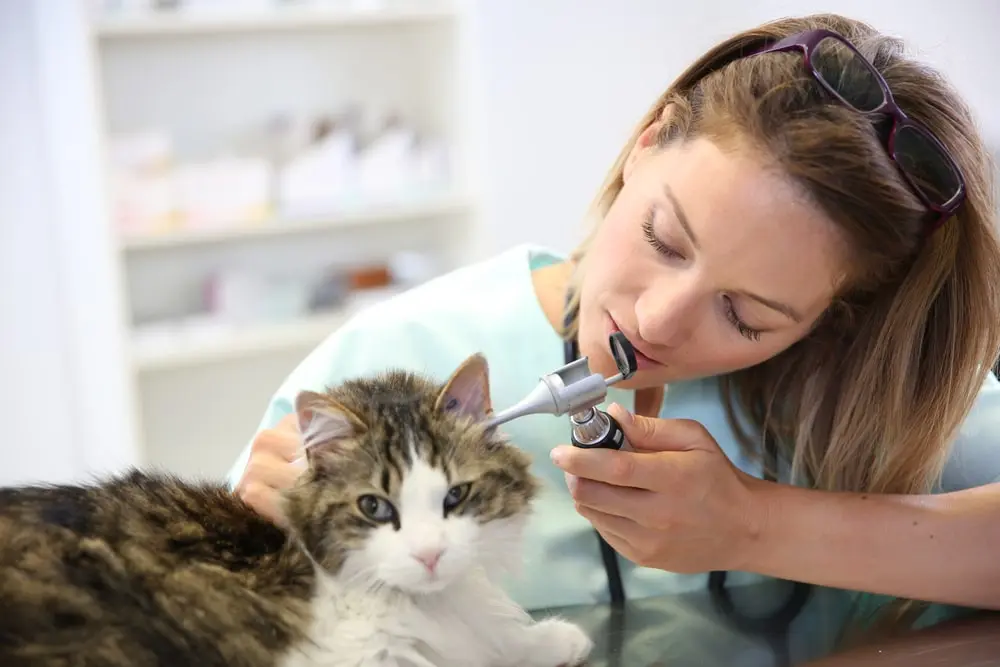PET HEALTH
Ear Infection in Cats: Symptoms and Treatment Options
Cat ear infections may not be as common as those in dogs, but when they occur, they can cause discomfort for your feline friend. Recognizing the signs of an ear infection — like head shaking, pawing at the affected ear, or discharge — can help you get your kitty the care they need quickly.1
Keep reading to understand the causes, symptoms, and treatment options so you can take action to ensure your cat stays happy and healthy.
When In Doubt, Get Your Cat Checked Out
What Causes Ear Infections in Cats?
Feline ear infections can happen when an underlying issue is at play. Common causes of ear infections in cats may include:1,2,3
- Ear mites: These tiny parasites can irritate the ear canal and create an environment for bacterial or yeast infections to develop.
- Bacteria or fungi: Many types of bacteria and fungi can cause an ear infection, not just those from ear mites.
- Foreign bodies: Small objects or debris — like hair, dirt, dust, plant material, or wax buildup — can get stuck in your cat’s ear, trap bacteria, and lead to irritation or an infection.
- Polyps or tumors: Growths within your cat’s ear canal can cause blockages that may lead to infections. These might need to be removed surgically.
- Environmental allergies: Allergies to things like pollen, dust, or mold can cause inflammation, making your cat’s ears more prone to infection.
- Existing skin conditions: Some cats are prone to skin issues, like dermatitis, which can extend to their ears and cause infections.
Anything that irritates your cat’s ears or causes inflammation could lead to an infection.2 Recognizing the cause is the first step in helping your cat feel better.
Types of Cat Ear Infections
There are three types of ear infections cats can experience:
- Outer ear (otitis externa): This affects the outer part of the ear canal.1,2
- Middle ear (otitis media): This involves inflammation of the middle ear, often caused by an infection or a punctured eardrum.4
- Inner ear (otitis interna): This is a very serious infection of the inner ear, which can lead to deafness or loss of balance.4
Depending on the type of ear infection your cat has, they may show different symptoms.
Symptoms of Ear Infections
Common signs of an ear infection in cats may include:1,2,3,4
- Black, brown, or yellow discharge
- Excessive wax or fluid buildup
- Scratching or rubbing the ears
- Pungent smell
- Head shaking
- Redness or swelling
- Sensitivity to touch around their ears
A middle or inner ear infection can have any of the above signs, but may also come with more severe symptoms, like:2,4
- Loss of balance
- Tilting the head to the side of the infected ear
- Facial paralysis
- Drooping eyelids or a sinking eyeball
- Eye movements from side to side
If you see any of these signs and symptoms of an ear infection, it’s a good idea to take your cat to the vet for a proper diagnosis and treatment.
How Vets Diagnose an Ear Infection
Your vet will likely examine your cat’s ears with an otoscope — a small, magnifying instrument that lets them see inside the ear canal to determine where the infection is or the cause. They may also take a sample from your cat’s ears with a cotton swab to test for bacteria or yeast.1,2
For suspected middle or inner ear infections, or when more severe symptoms are present, your vet may recommend further testing. Diagnostics like X-rays, computed tomography (CT) scans, or magnetic resonance imaging (MRIs), can help determine the extent of the infection.4
In some cases, your cat may need to be sedated for these procedures to keep them safe and calm.1,2
Treatment Options
Treating a cat’s ear infection depends on the cause and severity of the infection. Your vet will create a treatment plan based on your cat’s specific needs.
Treating outer and middle ear infections
For outer and middle ear infections, your vet will likely prescribe a combination of medications — such as antibiotics, antifungals, anti-inflammatories, or antiparasitics — to fight the infection and reduce inflammation. These typically come in the form of ear drops you’ll need to apply.1,2,4
In more advanced cases, oral medications or injections may also be necessary to fully treat the infection alongside a thorough cleaning of the middle ear.2,4
Treating inner ear infections
Inner ear infections can be treated a bit differently. If your cat’s eardrum is healthy, your vet may recommend antibiotics and anti-inflammatories, along with regular follow-up visits to monitor your cat’s progress.4
If the eardrum is damaged and there’s chronic inner ear inflammation, even when the infection is treated, cats may develop long-term issues like nerve damage, hearing loss, and balance problems.4
Catching and treating inner ear infections is key to preventing more serious complications. Cats who receive prompt treatment often respond well to prescription medications. In some cases, if an infection becomes chronic or isn’t treated early enough, surgery may be required to treat the problem.4
How To Prevent Your Cat From Getting Ear Infections
Most cats don’t need routine ear cleaning — but if your kitty is prone to chronic ear infections, cleaning can be a great way to help prevent them.2,5
If you notice discharge, buildup, or a smell, use a vet-approved ear wash and some cotton balls, along with treats to keep your cat occupied. Gently clean the ear flaps and outer parts of your cat’s ears with the cleaner and cotton ball. Go slowly and offer treats to keep your cat calm and comfortable during the process.5
You can schedule an ear cleaning with your vet if you’d prefer it be done professionally.
Are home remedies a good idea?
Infections need professional care to address the underlying cause.¹ Attempting to treat your cat’s ear infection at home without guidance from a vet could complicate or worsen the situation.
At-home remedies can introduce more debris into your cat’s ears, potentially causing further damage. And inserting cotton tip applicators or any other objects into your cat’s ears could come with the risk of rupturing their eardrum.5 Seek out professional veterinary care once you notice any signs of an ear infection.
MetLife Pet Insurance Could Help Cover Ear Infection Costs
Ear infections can be uncomfortable for your cat, but knowing the symptoms and acting early can make a big difference in their recovery. Cleaning their ears when you notice discharge or an odor, alongside prompt vet treatment, can also help prevent more serious (and costly) procedures, like surgery.
Fortunately, a cat insurance policy through MetLife Pet can typically help cover costs associated with cat ear infections — like prescriptions, follow-up vet visits, X-rays, and more. Get a free, personalized quote today, and create a plan that helps keep your furry friend healthy and your finances happy.
Dr. Hunter Finn has been paid by MetLife to discuss the importance of choosing pet insurance. He is an integrative veterinary expert first, and social media star second. America’s favorite veterinarian owns Pet Method in McKinney, Texas, where he cares for pets while prioritizing their emotional well-being. When he’s not at his clinic, he’s starring in viral videos on TikTok (2 million followers) and Instagram (500K followers) — where he’s been known to snuggle puppies and conquer the latest dance trends.



